Iceland: How much things cost & how to visit on a low budget
Since its currency crash in 2008, Iceland had gone from absurdly expensive to somewhat reasonable in cost, and that has prompted thousands of new tourists to stream in to see what all the fuss is about. It’s hard to find a visitor to Iceland who didn’t absolutely love the place, but you won’t find anyone who tells you it’s cheap, so planning ahead is essential. Prices have continued to creep up in 2015 and 2016, so it’s again among the most expensive European destinations.
Many visitors arrive on an Iceland stopover going between North America and Europe, but with very cheap flights to and from Europe it’s becoming popular for adventurous types from all over the continent. In 2013 I spent 9 days in the country, always checking for prices and the cheapest ways of doing things, so below I can lay out how to budget and what to do to keep costs down.
Note: This article was first written in late 2013, but all prices have been updated as of December 2016 to be current through 2017.
Reykjavik vs. the rest of Iceland: Where to go
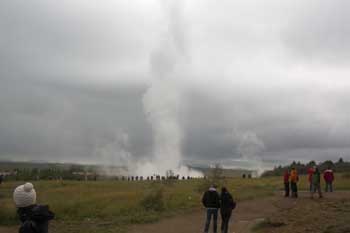
If you have one night or a few nights you are better off taking a bus or renting a car directly from the airport and heading east along the southern coast for some of the country’s best sights. If you have at least a week you’ll want to rent a car and do a lap around Iceland’s famous Ring Road, allowing you to see nearly everything the country has to offer in a neat and organized way.
Iceland accommodation: Hostels, guesthouses, and hotels
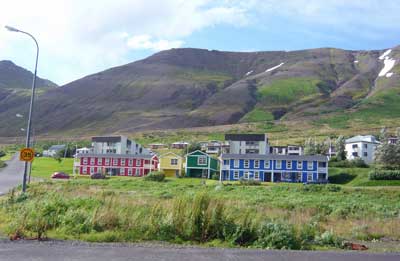
The most common form of accommodation in Iceland is a guesthouse and hostel combination which will have a mix of private rooms and dorm rooms, with shared bathrooms in down the hall. Most of them have fully equipped shared kitchens, so self-catering is at least as popular as eating out while exploring Iceland outside of Reykjavik.
High season (June through August) typical accommodation prices
All prices quoted in US dollars at a rate of about 110 Krona to US$1 in December, 2016.
- Hostel dorm bed: US$34 to US$58
- Single private with shared bathroom: US$85 to US$135
- Double private with shared bathroom: US$118 to US$140
- Double private with en-suite: US$130 to US$320 (and up)
Prices in Reykjavik are a bit higher than elsewhere in the country, but not by much. Prices in the off season are about 30% lower than in high season, but in the slowest months many places close so rates never go much lower than this.
Most Iceland guesthouses are NOT on the normal hotel-booking sites
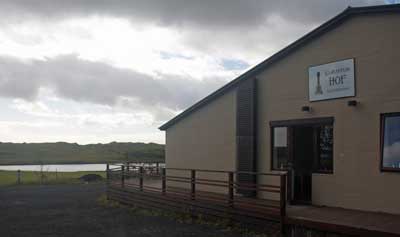
The good news is that when you get to Iceland, the tourism office will give you a directory of almost every guesthouse on the island, and there are other ways of finding these guesthouses and other informal accommodations. Even as of late 2016 you should be able to book a double room (with shared bathroom) for about US$120 per night in most towns in Iceland. If you do a hotel search you might see prices that are double that, but those are in the few formal hotels with 24-hour lobbies and such.
Increasingly, Airbnb and other online rental sites are the best place to find guesthouse accommodation in Iceland. As of only a few years ago, most places would be booked by phone or in person on arrival day, but now more and more places can be pre-booked, at reasonable prices.
Sleeping bag accommodation in Iceland
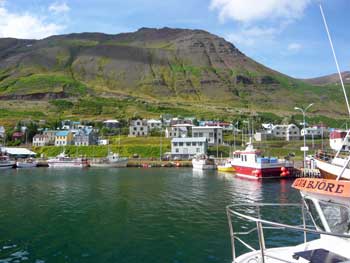
In a ‘sleeping bag accommodation’ (as it’s known in Iceland) you’ll get a bed with a mattress and often a pillow. So with even a cheap indoor sleeping bag, you’ll be comfortable and warm while saving quite a bit of money. For those renting cars, this is a highly recommended strategy.
You can rent sleeping bags in Reykjavik starting at around €12 per week.
Most Iceland attractions are free (the good news)
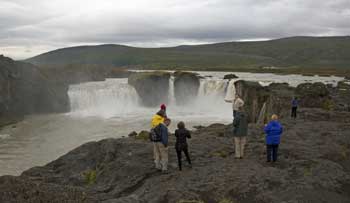
So to see all the glaciers and waterfalls and volcanic beds and other scenic attractions, it’s all free of charge with no admission cost or even parking fees. The larger attractions also have visitor centers where you can get local advice for free as well.
Iceland transportation: Rental cars and buses
Even as a lifetime public transportation fan, I’m very glad I gave in and rented a car to tour Iceland, even as a solo traveler. For the most part the roads are in perfect condition and virtually empty even in high season, so driving couldn’t be easier. Also, the country has stunning vistas every time you turn a corner, so being able to stop in the middle of the road even if there is no room to pullover, is critical.
The buses are modern but also expensive and running on very limited schedules. If you only have enough time to cover the main sights along the southern coast you might buy one of the bus passports that allows you to hop on and hop off, though a rental car is still much better and easier.
Rental cars in Iceland: What you need to know
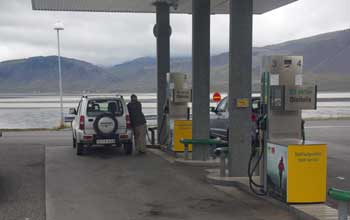
For an extra fee you can pay to reduce that deductible to almost nothing, but the more popular add-on is the Gravel and Glass insurance. For around €10 per day with this coverage you have a zero deductible if the vehicle gets damaged by gravel or if any glass gets broken by flying rocks (or anything else). Unfortunately, many of Iceland’s side roads and even a few of the main roads are covered in gravel, and if you drive at anything above a crawl, there will be some gravel flying around.
Personally, I normally decline add-ons like this but in this case I bought the Gravel coverage after reading a few horror stories in online reviews. I didn’t get any damage that I’m aware of, but the peace of mind was worth a LOT when driving on isolated gravel roads so I wasn’t petrified that I was chewing up the paint job just trying to stay safe on the roads.
Rental cars in Iceland
- 2-wheel drive compact (manual): US$230 per week and up plus add-ons
- 2-wheel drive compact (automatic): US$270 per week and up plus add-ons
- 2-wheel drive mid-size: US$450 per week and up plus add-ons
- 4-wheel drive van or SUV (automatic): US$650 per week and up plus add-ons
Daily rates are about 20% as much as weekly rates, so 5, 6, or 7 days cost the same.
Add-ons
Gravel coverage: US$10/day
GPS (highly recommended): US$10/day
Additional collision waiver: US$10/day
Fuel prices in Iceland
Every gas station in the country has the same prices, which don’t seem to change much. As of December 2016, a liter of petrol is 194 Krona, which is about US$1.75 or €1.63, or about US$7.50 per gallon.
Bus pass prices in Iceland
For a quick day trip from the airport to some local sights you can spend as little as US$90 per person, but for the longer distance buses you’ll spend at least US$130 to US$250 depending on length of time in order to hop on and hop off.
A Ring Road passport will cost around US$400 per person, so for two people it’s no cheaper than renting a car, even after fuel is taken into account, and for 3 or 4 people it’s definitely cheaper renting a car.
Food prices in Iceland
Here’s the thing: sit-down restaurants in Iceland are very expensive by international standards, so there aren’t very many of them. Obviously Reykjavik has many restaurant choices but most smaller towns might have only a few at most. The good news for budget travelers is that fast-food options are more plentiful, and self-catering is even cheaper and easier.
Restaurant prices in Iceland
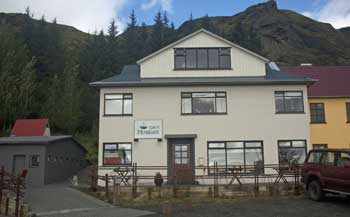
A soft drink, coffee, tea, or even bottled water will generally be between US$3 and US$5 in a restaurant. A pint of beer will typically start at around US$7 at even the cheapest places, while wine and spirits cost even more.
Fast food prices in Iceland
In Reykjavik and larger towns (which might only have 2,000 residents) you’ll have many fast food options including Subway, Quiznos, and usually a few local burger or hot dog places. Prices for a sandwich at Subway are about US$6 for a 6-inch and US$10 for a foot-long, so they aren’t too much higher than elsewhere in Europe, and are sure cheaper than proper restaurants.
More good news for drivers is that many gas stations around the country have fast food restaurants built in, so it’s fast and easy to pick up a sandwich or hot dog by the side of the road.
Hotel breakfast prices in Iceland
Many hotels and guesthouses in Iceland serve breakfast, but it’s almost always at an extra fee, and many don’t serve anything at all. If a breakfast is offered it will typically cost between US$12 and US$15 for a buffet of cereals, bread, cold cuts, cheeses, hard boiled eggs, juices, coffee and tea, and perhaps some pastries.
Making your own self-catering breakfast will be cheaper, but since you can stuff yourself for a flat fee at the breakfast buffets it might be worth it to save yourself the hassle of shopping the day before and making breakfast in the morning.
Self-catering in Iceland
The best budget tip for Iceland is to buy and prepare your own food, and you can literally do it for all three meals per day if you prefer. Since Iceland has almost no national “must-try” dishes, you can buy and prepare your own food without worry about missing anything meaningful.
Nearly every guesthouse in Iceland has a shared kitchen where at least half the guests will be storing and preparing breakfasts and even dinners. They have refrigerators, coffee makers, electric kettles, pots, pans, dishes, and silverware, as well as salt and other spices, so you can buy just the food and you’ll be able to prepare it all.
Supermarket prices in Iceland

For example, you can buy a 400 gram (1 pound) block of Havarti cheese for around US$5, but a similar looking cheese right next to it on the shelf might be US$15 for the same amount. The same is true for lunch meats. Sliced ham can be US$3 for enough to make 2 sandwiches, but sliced roast beef might be US$10 for the same amount.
Some sample prices in the cheaper Iceland supermarkets
- Sliced white bread: US$1.70 per large loaf
- Fresh baguette: US$1.50 to US$2 each
- Hot dog buns: US$2.50 for 5
- Pork hot dogs: US$3.50 for 5 large hot dogs
- Cheap Havarti or other local cheese: US$5 for 400 grams (1 pound)
- Imported cheese: US$10 to 15 for 400 grams (1 pound)
- Sliced ham for sandwiches: US$5 for 400 grams (1 pound)
- Sliced roast beef for sandwiches: US$12 for 400 grams (1 pound)
- Pasta: US$1.50 for .5 kilogram (1.1 pounds)
- Pasta sauce: US$3 for a .5 liter jar
- Ground beef: US$5 for .25 kilos (half pound)
- Bake-at-home pizza: US$5 to US$7 for one person
- Bag of tortilla chips for 2 or 3 people: US$2
- Jar of salsa for those chips: US$3
- Breakfast cereal: US$3 to US$5 per box
The prices above are for many of the cheaper and more common things that budget tourists buy in Iceland. As mentioned above, if you want something exotic and imported, it might cost double or triple what you pay at home, if you can find it at all.
Alcohol prices in Iceland
In restaurants and bars throughout the country you’ll pay at least US$8 for a pint of beer, and at least US$10 for a glass of wine or a simple cocktail. If it’s a fancy place you’ll pay even more, of course.
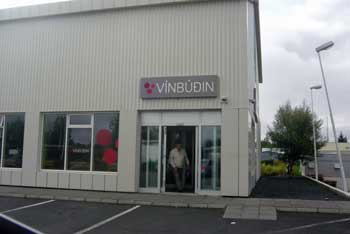
Here are some typical prices for alcohol:
- 330ml can of local beer: US$2 to US$3
- 500ml can of local beer: US$2.50 to US$4
- Cheapest bottle of wine: US$10 to US$12
- .7L bottle of off-brand vodka: US$30
- .7L bottle of mid-level brand vodka: US$50
Bottom line on doing Iceland as cheaply as possible
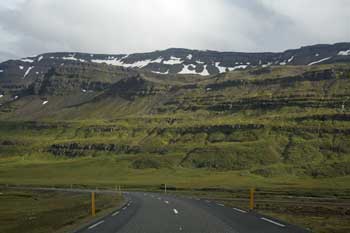
Whether you are going to get dorm beds or private rooms, as long as you will have your own wheels it’s worth renting a sleeping bag. You get the same bed and same services for about US$10 less per night, which will pay for a week’s rental of an indoor sleeping bag.
Unless you are a terrible driver or afraid to drive, it’s highly recommended to rent a car instead of trying to get around using buses. Once you get there you’ll see that having 100% flexibility with a car compared to almost no flexibility with a bus, is worth a LOT.
Instead of trying to be cheap with transportation, be cheap with self catering food and drinks for yourself. If you have at least a small group of people you’ll be able to have a party each evening in or near the shared kitchen of your guesthouse, and it will be more lively than any restaurant in town.

Hie Roger,
Very useful link.
I’m planning a self drive tour of Iceland full circle in December last week for 12 days, need some tips for it.
I know that full circle is not possible considering the road conditions which may be closed for some parts of north.
My biggest concern is how much daylight I’m going to get( I’m assuming max 5 hrs) for sightseeings.
Secondly, we’re vegans so food would be difficult so we have to manage in advance.
And lastly, we need to get a 4×4 for December conditions.
Do you have any info that I can use?
Thanks,
Anand.
Anand,
I’m not sure how much help I will be because I’m an omnivore who has visited in summer. I wouldn’t be surprised if a few parts of the Ring Road were closed at times in winter. There are still a few short sections that aren’t yet paved, and if they get a lot of rain they could easily be unpassable in a 2WD vehicle. I’m sure you can find better information on December road conditions elsewhere. A 4WD vehicle does open up the road under more conditions, but they aren’t cheap.
As for the daylight I’ve spent a couple of periods in winter at latitudes not far from that, and it is weird. In my experience it’s more like dawn or dusk for many hours, rather than being dark and getting light and then getting dark again. However, I’m sure you’ll find better information on that elsewhere.
I don’t think being vegan will be a problem though. There are so many vegetarians on the road that I think any restaurant or fast food joint will have to have at least one or two main options. Nordic people enjoy their meat, but they have a tourism boom and I’m sure they take care of guests. Also, there are little supermarkets in many towns you’ll drive through each day, and most guesthouses have community kitchens. That’s really your best bet anyway because the sit-down restaurants in Iceland are very expensive, and there aren’t many of them in general. Best of luck on all of this. -Roger
Hi- What months are considered low season and which hi season? I would like to take my adult kids there in December (about the 9th for a week).
Thanks- Lise
Lise,
Since Iceland is obviously so far north of the equator, the summers are short and a bit chilly. So the main high season is June through September, with July and August being the peak months. The rest of the year is fairly quiet and many guesthouses and some restaurants even close until the next summer. However, from November through February there is a new boom in Northern Lights tours and visits. If you go in mid December it will be dark most of the day, with the sun coming up at about 11am and then going down by 3pm or so without ever being overhead. If you want to see the Northern Lights it’s the perfect time of year. But if you want to see the other amazing scenery such as the waterfalls and hot springs, then December is not ideal. Best of luck with whatever you decide. -Roger
Hi Roger,
This is very helpful to a female solo traveler like me. but would like to ask if any chance you’ve seen the Northern Lights? I am planning to do a week trip this october. And one of the reasons i am going is to see it.
Thank You
Josefina
Josefina,
Interestingly, I once saw the Northern Lights on a red-eye flight from Los Angeles to New York City, but not yet in Iceland. It seems like the organized Northern Lights tours in Iceland tend to run between November and February, so it appears that those are the most reliable months. But people say that starting in September it is possible, so fingers crossed that you’ll get that chance. I wish I had more information for you. -Roger
Thank you, Roger, for your time, for putting your heart into giving detailed and valuable answers (to me and all other people). You are phenomenal, really. May God/Universe/Higher Power bless and protect you and your loved ones! And all the best on your next trip to Iceland. (By the way do icelanders know having such a strong country advocate in you?:)) Piece, Laima
Laima,
Thank you for the kind words. I’ve been fortunate enough to be able to make a decent living by doing travel research and advice, and I enjoy trying to help people plan trips. -Roger
Hi Roger,
I’m like all of these people above got fascinated with your helpful, down to the earth article and the fact, that you’re still helping to answer their questions, even though you posted your article in 2013 for the first time!
We are going to be in Iceland in August for two nights only, as we having two days layover before next flight. Could you give us some ideas/advice where and what we could see not far away from Keflavik airport. Nature would be definitely a point of destination rather than Reykjavik. And you said that booking hostel online not necessary reflect the real situation. Do you think looking for the hostel once we arrive to the airport is good idea?
My sincere thank you in advance!
Laima,
That is very nice of you to say. I guess it may not be obvious that this is actually my full-time job (writing for and running this travel website) so I try to stay up to date. I’m also planning on going back to Iceland myself again next year if possible.
As for your question, I’d rent a car if possible, even for two days. You can pick up a car at the airport and never have to even go into Reykjavik. There are loads of great natural sights in the southwest corner of the island, and you could even drive as far as Vik in about 3 hours from the airport. The scenery is stunning and there are some very good sights along that road. You could stay both nights in Vik, or maybe just the first night and then somewhere closer to the airport on the second night, depending on when you flight is.
The most popular thing to do on a shorter layover is what they call the Golden Circle (not to be confused with the Ring Road), which connects a very impressive waterfall, the Geysir that gave us the word “geyser”, and the site of the continental divide (not as interesting as it sounds). You can do that on a bus trip and be back at the airport in 8 hours or so. So that is an option, but you will get big crowds on a bus group, while if you drive yourself you will probably be nearly alone. Also, there are better waterfalls and other sights on the way to Vik and back. Any combination of those things will be really fun.
As for booking a hostel or guesthouse, I’d say it’s worth booking in advance in your situation. When doing the Ring Road it can be unpredictable as to how far you get each day. But in your case you can’t really mess around much so if I were you I’d feel better about locking in a good place that you know you can get to. I’m happy to help with other questions if you have them. I’d also recommend getting Lonely Planet Iceland or at least using the info on their website. They do a great job of telling you which are the better sights in each area and it’s very helpful to have solid advice on a tight schedule like yours. Also, the Blue Lagoon is close to the airport and it’s actually very cool to at least see. You can go in and look around for free, but if you want to get a locker and swim it is kind of pricey (although worth it). Have a fantastic trip. -Roger
Hi Roger
Motorhome or no Motorhome??
Thank you for the amazing and helpful information.
I have tried to read through as much as possible to gain the information Im after, but got side tracked by all the info.
Just a few questions if possible and I do apologize if they have been asked and answered:
We looking to head to Iceland 17-30 Sept, and debating to rent a Motorhome or regular vehicle?
The camp card is great but many of the sites close by 15 Sept, which leaves vast distances to the next place. struggling to find info on which campsites remain open all year round?
And with new camping rules I am skeptical?
Cost wise we have established that the diff between car rental and motorhome for the time isn’t that much?
Any insight would be highly appreciated.
Thank you
Orlee,
I haven’t taken a motorhome in Iceland myself, although I did that in New Zealand and absolutely loved it. Recently I got a similar question about year-round campgrounds and I found that a Google search came up with a very helpful map. The good news is that those year-round campgrounds seem to be nicely spread over the popular parts of the island. So while you may not have many choices in any given town, you will probably have at least one choice within a very short drive of where you’d want to stop. And I seem to remember that some others stay open through the end of September, so your choices will probably be greater. Let me know if you have any other questions. -Roger
My daughterand I will be traveling to Iceland this August for one week. We love adventures and also saving a buck or two in the process. Is it possible for us to sleep in our vehicle most of the trip and hit a hostel one or two nights so we can shower?
Lisa,
Yes, you could do that if you only need that many showers. However, the even better news is that there are campgrounds in all of the popular areas of Iceland, and most of them have spots where you can park a vehicle and get electricity and such. And of course if you pay the modest overnight fee you can also use their bathrooms and showers. Check for Iceland campgrounds in a search and you’ll get all the details. Best of luck with this. -Roger
Hi Roger
Hope this finds you well. Thanks for helping me out with your suggestions for Germany, Czech Republic and the British Isles in the recent past. I could not have done these trips without your inputs.
I am planning to visit the Nordic countries starting with Iceland from mid-July onwards. I don’t have an international driving license so will be relying on public transport. For Iceland can you please recommend the top sites and towns where I should be staying overnight (shared accommodation like hostels or the next available cheapest option) and approximate number of days that I should budget for each place. I haven’t done proper research but the towns I have in mind are Hofn, Vik, Akureyri, Myvatn, and Reykjavik (happy to add or remove as per your suggestions). Time is not really a constraint but I want to be selective about the places I visit (instead of trying to see everything) and with a moderate pace I hope to spend about 7-10 days in Iceland. For the Ring Road bus option, how many days do I need? And does it involve making day trips and then coming back to a particular starting point, or can I keep moving along and stay at different towns on the way? My entry and exit point will be Keflavik Airport (I will be flying in from Portugal and then heading to Denmark or Norway).
Sorry for bombarding you with all these questions in a very abrupt manner. Look forward to your reply.
Regards,
Neo
Neo,
I’m very happy to hear that my advice has helped you in the past. As for Iceland, these are some challenging questions. On my own trip I spent two nights in Reykjavik and then did the Ring Road in 7 days. I used the ebook version of Lonely Planet Iceland, which I highly recommend. Basically what I did was check the areas I would cover each day of driving and note the most recommended sights that I should plan to stop at. As you’ve seen, the names of everything in Iceland are almost all long and difficult to pronounce for non-Icelandic speakers. So it’s very hard for me to remember ANY of them, much less my favorites of them.
I thought about taking the Ring Road bus, but everything I read said that renting my own car would be a worthwhile splurge, even as a solo traveler. I had an amazing time and I plan on going back soon with my girlfriend. But it’s hard to give the sort of advice you are after. My top suggestion would be to buy Lonely Planet Iceland, or any other proper guidebook, whether by ebook or paper book. It will be the best US$20 or US$30 you’ll spend on such an expensive trip.
My understanding was the the Ring Road tourist buses would stop at the major waterfalls and other sights as it went, and then also stop in the towns with guesthouses and hotels. But I’m honestly not sure. Along the southern coast between Hofn and Reykjavik there are more sights worth stopping at than the northern part of the Ring Road. On my next trip I will explore more about how the buses work and I’ll update this post. Sorry I can’t help more and let me know if you have any other questions you think I might know. -Roger
Hi Roger
We are a family of four adults planning to visit Iceland March 2018. I was told as well as read articles driving in Iceland during winter can be hazardous and dangerous and decided not to hire car instead and inquired with local Travel agents. We were quoted Euro2984.00 for a 4 nights package which includes :
Transfer from Keflavík Airport to Reykjavik via Airport Shuttle on arrival
Greater Reykjavik area sightseeing bus tour (2.5 hours)
Golden Circle Guided bus tour (8 hours)
Northern Lights guided bus tour
(3 – 5 hours), Kleina (Icelandic Pastry) and a Hot chocolate
Blue Lagoon & Keflavík Airport transfer via Airport Shuttle on departure (entrance fee included)
We are not comfortable driving especially in icy conditions – do you think the price of the package is fairly reasonable or a little too much ?
Also requested for apartment type accommodation with cooking facilities after reading how expensive it can be eating out especially with 4 adults. Would this be a good choice or stick with breakfast included but no cooking facility ?
Many thanks for your advice in advance Roger 🙂 So good to learn so much just by reading your posts.
Hawk,
That price does seem a bit high, but Iceland isn’t a cheap place to visit so it’s hard to tell what a more reasonable price might be. You could find prices on each individual item pretty easily, and if you really wanted to you could book most of these same things online. I’d think that probably at least half of that total will go toward accommodation. At this point even a simple hotel room with shared bathroom (most hotels in Iceland operate this way) is going for around €200 a night in the better locations. So if you are getting an apartment with a proper kitchen, that would go for at least €300 per night, I’d think. With that in mind, and it could be up to €400 per night really, it’s not such a bad deal. Again, you could book all of these things individually, so that is the best way to compare the price.
If the total is much less than this price you might even want to just do it yourself. Iceland is a VERY easy country to visit in that everyone speaks fluent English and almost everything is available online. Also, it should be pretty quiet in March, so I don’t think any of these things will be sold out in advance.
As for the cooking thing, I think it’s a good idea. As amazing as Iceland is as a destination, there are no local specialty dishes that anyone really needs to try. There are many fast-food restaurants where a meal is around €10, and any sit-down place will start more like €20 and go way up from there. It’s just not good value, which is one reason why most guesthouses in Iceland have public kitchens that get used a lot. Let me know if you have any other questions. -Roger
Hello Roger,
Firstly, your blog is fabulous, detailed and helpful!
I am going to iceland from Sept 2 to Sept 9 with my husband. I land in Iceland on Sept 2 at about 3pm and leave on Sept 9 at 6pm.
Given that i have 8 nights – here is how i plan to break-up my trip.
1. Sept 2 night we stay in Reykjavik
2. Sept 3 morning we leave and drive clock-wise on the ring road and we plan to be back in Reykjavik by night on Sept 8th.
Could you suggest a suitable itinerary with specific must visit sights for me?
We plan to do Blue lagoon on 9th morning, on our way to the airport.
Look forward to hearing from you. Thanks.
Sache,
Thank you. I really don’t like to build itineraries from scratch, although I will comment on one that someone posts here if they ask. When I did my clockwise Ring Road trip I used the Lonely Planet iPad version (any version will do) and I noted the interesting waterfalls, springs, and other sights that were on or near the Ring Road each day. Unfortunately, the Icelandic names are mostly unpronouncable and very hard to remember for English speakers, so very few of them stuck with me.
One wonderful thing about the Ring Road is that most of the best sights are literally next to the Ring Road, or down a short road that is well marked. In other words, even without a guidebook you’d end up seeing most of the best options. Still, I recommend a guidebook as it’s the best US$10 or US$20 you’ll spend on a trip that will cost you a couple thousand dollars.
A last thing I’ll mention is that you may not want to spend that last night in Reykjavik. It’s a pretty dull town and you might be too tired to do any sightseeing when you get back there. What I did was found a spacious hotel in a suburb, which was maybe 30 kilometers from Reykjavik. Hotels outside of town are much cheaper and more spacious, and parking is obviously easier as well. The road from the capital area to the airport is an easy one that is empty most of the time, so if you stay anywhere in southwestern Iceland it will be easy to drive to the Blue Lagoon on your way to the airport. Let me know if you have any other questions. -Roger